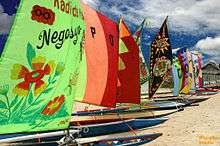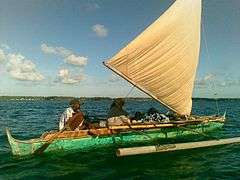Vinta


The vinta (also generically known as lepa-lepa or sakayan) is a traditional boat from the Philippine island of Mindanao. The boats are made by Sama-Bajau and Moros living in the Sulu Archipelago,[1] Zamboanga peninsula, and southern Mindanao. It has a sail with assorted vertical colors that represents the colorful culture and history of the Muslim community. These boats are used for inter-island transport of people and goods. Zamboanga City is known for these vessels.
In 1985 the vinta Sarimanok was sailed from Bali to Madagascar to replicate ancient seafaring techniques.[2][3]
Other uses
"Vinta" is also the name of a Moro dance that commemorates the migration of Filipinos into the archipelago. In the dance, dancers imitating the movements of the vinta (vessel) by balancing perilously on top of poles. PAREF schools in the Philippines have adopted the vinta as their symbol.
See also
References
- ↑ Doran, Edwin, Jr., Texas A&M University (1972). "Wa, Vinta, and Trimaran". Journal of the Polynesian Society. Auckland, New Zealand: University of Auckland. 81 (2): 144–159. Retrieved January 7, 2015.
- ↑ "Across the Indian Ocean, aboard prehistoric ships..."
- ↑ "Navigation Instruments". Sundials Australia.
External links
- Vinta at Pacific Tall Ships
- Culture of Mindanao
- The Voyage for Love and Peace, from a dance company
- 1930s images of vinta:
